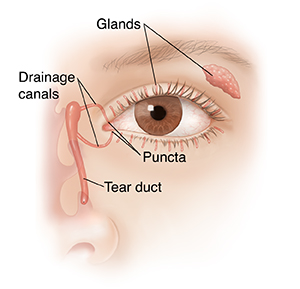A
B
C
D
E
F
G
H
I
J
K
L
M
N
O
P
Q
R
S
T
U
V
W
X
Y
Z
Topic IndexLibrary Index
Click a letter to see a list of conditions beginning with that letter.
Click 'Topic Index' to return to the index for the current topic.
Click 'Library Index' to return to the listing of all topics.
What Are Dry Eyes?
Do your eyes ever sting, burn, or feel scratchy? To be comfortable, your eyes need to be bathed, or lubricated, with tears. Normally, there is always a film of tears on the surface of your eyes. But if your eyes don’t make enough tears or the tears are of poor quality, the surface gets irritated. This is called dry eyes.
Not enough lubricating tears
When you cry, get something in your eye, or have an infection, your eyes make reflex tears. Each time you blink, another kind of tears (lubricating tears), spread over the surface of your eyes. These tears keep the eyes moist and comfortable. You aren’t aware of these tears because they stay on the surface of your eyes.
Without lubricating tears, your eyes get dry. Then they burn or sting and feel scratchy. They may also water. But this doesn’t ease the dryness. That's because the eyes water with reflex tears, not lubricating tears.
What causes dry eyes?
-
Aging
-
Heaters and air conditioners
-
Wind, smoke, or dry weather
-
Allergies, such as hay fever
-
Medicines
-
Eyelid problems, injuries to the eye, or diseases, such as Parkinson, lupus, or rheumatoid arthritis
-
Eye surgery, such as LASIK
-
Contact lens use
-
Diabetes
-
Vitamin A deficiency (rare in the U.S.)
How lubricating tears flow
Lubricating tears flow from glands in your upper eyelid over the surface of your eye. From your eye, the tears drain into small openings (puncta). These connect to drainage canals that lead to your nose.

Online Medical Reviewer:
Chris Haupert MD
Online Medical Reviewer:
Tara Novick BSN MSN
Online Medical Reviewer:
Whitney Seltman MD
Date Last Reviewed:
12/1/2022
© 2000-2025 The StayWell Company, LLC. All rights reserved. This information is not intended as a substitute for professional medical care. Always follow your healthcare professional's instructions.